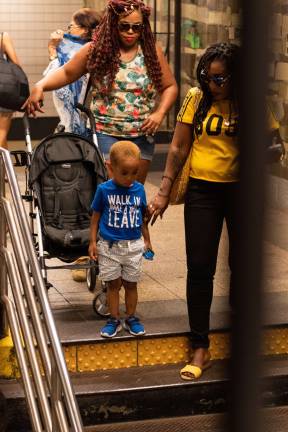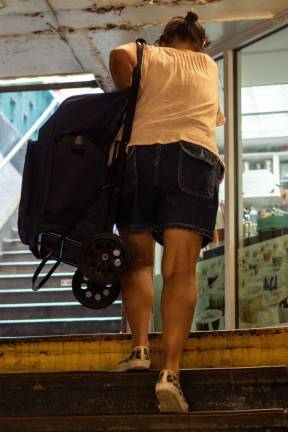subway inaccessibility is a burden for many


Julie Maury didn’t feel safe taking the subway alone until the Second Avenue station was revamped — and even then, she has only taken three subway rides by herself. The 36-year-old is wheelchair-bound, and relies on the buses. Each use of public transportation is an ordeal.
“To rely on the bus system heavily like I do, I have to start out an hour or maybe two hours in advance if I want to go somewhere, whereas a friend without a wheelchair may have to start out 15 minutes in advance because they have access to the subway, where I don’t,” Maury, who lives on the Upper East Side, said.
New York City Comptroller Scott Stringer last month released a report detailing the lack of accessible subway stations across Manhattan, Brooklyn, the Bronx and Queens. According to Stringer’s office, 51 percent of neighborhoods don’t have American Disabilities Act-accessible subway stations. A majority are located in Brooklyn, the Bronx and Queens.
Nearly 500,000 people who need accessible stations do not live in a neighborhood that has one, according to the report. Non-ADA-accessible stations don’t solely affect those with a disability — mothers with young children, senior citizens and people with injuries also often depend on elevators.
An MTA spokesperson said New York City Transit has never been more committed to an accessible transit system than now.
“President Byford has hired the system’s first-ever accessibility chief, and his Fast Forward Plan includes a roadmap to dramatically expand subway accessibility, with customers no more than two stations away from an accessible station within five years, and continued elevator installations after that,” the spokesperson said, referring to the president of the New York City Transit Authority. “We’re also bolstering our completely accessible bus network, and we’re undertaking an overhaul and modernization of Access-a-Ride — all of which will lead to dramatic accessibility improvements.”
Currently, 118 subway stations are wheelchair accessible, and 26 more stations are in the works to become accessible. Nearly $5 billion has been invested in subway accessibility projects, and the MTA is devoting $479 million to replace existing elevators and escalators.
The comptroller’s office has found that the MTA is addressing the issue — the Fast Forward plan emphasizes the need for more stations, and the idea of having people no more than two stops away from an accessible station is geographically strategic. Stringer’s policy team, though, views the timeline as ambitious and needing funding.
Several advocacy groups are advocating for more access to public transportation. One such organization, Rise and Resist, has an elevator action group that specifically targets this issue through rallies, written recommendations to transportation authorities and coalition-building with other advocacy groups, according to organizer Jessica Murray.
Murray, a CUNY graduate student researching accessible transportation, said the lack of accessible transportation available to disabled New Yorkers affects their professional and social development.
“All the opportunities are near the accessible stations, but they can’t actually get from a non-accessible station to an accessible station, so they’re being held back economically and socially,” Murray said.
Inaccessibility also affects older New Yorkers, an issue that the American Association of Retired Persons, which serves the 50-plus population, has also spoken out about. Chris Widelo, the AARP associate state director for New York, said while New York City is considered a senior-friendly city, it needs to continue working toward that goal.
About 13 percent of New York City’s population is 65 and older, Widelo said, and the number will balloon to 20 percent within the next decade.
“New York state last year announced they intend to become the first state in the country to become age-friendly, that they’re going to take steps to achieve that,” Widelo said. “So this really will take a combined effort of our city and our state to realize that. But right now, I don’t think when only a quarter of the subway stations are accessible, we can claim that we’re doing a great job there. And we know that in some areas, there are whole neighborhoods that don’t even have one accessible station.”
He pointed out that the current subway station renovations are once-in-a-lifetime, and that the lack of accessibility plans for several of the renovations is a missed opportunity.
“And yes, there is a cost attached to it, but there’s also a cost attached to not having accessibility,” Widelo said. “So, I think we need to — New York needs to — raise the bar, and I think we’d like to be on the forefront of a lot of things, and I think it would really make a statement if New York and New York City took the challenge … so that the subway stations are accessible.”
Widelo recommended the MTA determine its short-term, intermediate and long-term plans to make stations more accessible. He also suggested that citizens reach out to government officials about the issue.
“It’s important that people get in touch with either their state legislators and Assembly or [state] Senate or even their City Council Member and really let them know about the concerns they have about accessibility,” Widelo said.
Christine Serdjenian Yearwood, the founder and CEO of UP-STAND, which advocates for pregnant mothers and families, said many mothers are forced to quit their jobs because they cannot safely travel to their workplace. Having to stand for long periods of time and not having access to elevators and escalators means that mothers and pregnant women may miss doctor’s appointments as well.
“From parents, specifically, a lot of moms I hear that this is really a safety concern in a lot of ways,” Yearwood said. “With a carrier, if you’re wearing a carrier, the balance and visibility are really difficult on the stairs, or [for] a lot of women postpartum, it’s against the doctor’s orders to be carrying that weight on your body, so a lot of women avoid the subway altogether.”
Yearwood also said the issue is true with strollers, as carrying single and double strollers while also holding children are unmanageable on the stairs of a subway station, rendering the entire system inaccessible.
Yearwood said the MTA’s typical response to UP-STAND is that the bus system is accessible to parents — which she disputes.
“I mean, we’ve seen in the reports that buses are slower and also that there are huge transit deserts basically for people where nothing is running or nothing is close enough for that,” Yearwood said. “And then there’s also this no-open-stroller policy on buses, which means that you have to take out all of your things and take your child out of the stroller, fold up the stroller, get on the bus where you’re not guaranteed a seat, and you’re supposed to be holding your child and all your things on a moving bus, and it’s pretty impossible.”
The wide variety of people affected has activists hoping the MTA will take the issue seriously and help create a more democratic public transportation system.
“We’re not some kind of weird subgroup — disability, it’s a common thing,” said Maury, the Upper East Sider. “Disability happens to anybody if they live long enough. It’s a human thing. It’s a thing that happens to human beings. You can break your leg, you know? So the thought should always come from a place of, how do we think of accessibility first and foremost instead of looking at it as some kind of burden.”